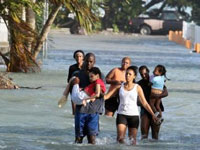 As Hurricane Sandy made its exit from The Bahamas on Friday, officials said it was too soon to fully assess the damage caused by the storm, which packed winds in excess of 100 miles per hour.
As Hurricane Sandy made its exit from The Bahamas on Friday, officials said it was too soon to fully assess the damage caused by the storm, which packed winds in excess of 100 miles per hour.
The storm resulted in downed power lines, severe flooding across the country and at least one death, according to National Emergency Management Agency (NEMA) officials.
Police reported that Lyford Cay resident Timothy Fraser Smith fell from his roof and hit his head on the concrete below as he attempted to secure a dislodged shutter.
Smith, 66, was the CEO of the offshore bank Deltec Bank and Trust Limited in Lyford Cay.
Police said the incident occurred around 9:30 pm on Thursday. A family member reportedly discovered him on the porch shortly after he fell.
Prime Minister Perry Christie, along with other government officials, was due to begin assessing the islands that were damaged by Sandy on Saturday.
“What we want to do is we want to bring immediate relief to people who may be in need,” Christie told The Guardian on Friday following a press conference at NEMA headquarters in downtown Nassau.
“That’s why it is so important for us to be in constant communication with our officers on the islands. This is the type of country where communication needs to be constant.”
Up to Friday afternoon, NEMA had not received reports from officials on some of the most affected islands.
Christie said the government will need to review the emergency communication system to ensure reliable communication during emergencies.
Hurricane Sandy made landfall in The Bahamas as a category two storm on Thursday.
NEMA director Captain Stephen Russell said a full assessment is not expected to be complete until Monday.
Several islands were without electricity, and in some cases water, up to Friday night.
“What we are experiencing now, a number of [the islands] have downed power lines which has resulted in the loss of line communications as well as their power in some of the islands,” Russell said.
“Many of the islands are experiencing quite a bit of flooding in the low-lying areas throughout The Bahamas — from San Salvador to Landrail Point (Crooked Island) where they reported experiencing tidal surges coming in [as high as] 25 feet, which has restricted access in some areas in that community.”
Russell said some homes on different islands were also damaged.
In New Providence, several roads were damaged and had to be closed, including West Bay Street in front of the caves.
Bahamas Electricity Corporation (BEC) officials were working to fully restore electricity to homes, BEC general manager Kevin Basden said.
Basden reported that about 55 percent of New Providence customers were without electricity at some point during the storm.
He added that many Family Islands experienced outages as well.
Lynden Pindling International Airport, which was closed on Thursday, re-opened on Friday afternoon. Airports on the Family Islands were expected to re-open Saturday or Sunday.
Russell said the Nassau port needs to be repaired before it can re-open.
“A number of the large fenders dislodged from the jetties but they are expected to be restored [today] so that the harbor can be re-opened to accept cruise ships,” Russell added.
Director general of tourism David Johnson said his ministry will get the word out to the rest of the world.
“We expect to provide an update from our external releases on the resumption of service,” Johnson said.
“And we do know that as of [Friday] afternoon the American consumers are focusing on Sandy entering to the northeast, which means that it is traveling away from The Bahamas and the Caribbean.
“But before that happens we want to ensure that the message that we are back open and ready for business is with them.”
By Krystel Rolle
Nassau Guardian Staff Reporter

